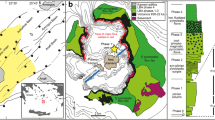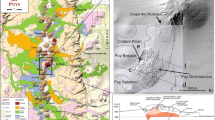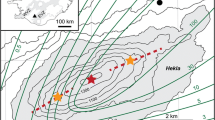Abstract
We use the deposit sequence resulting from the first catastrophic caldera collapse event recorded at Santorini (associated with 184 ka Lower Pumice 1 eruption), to study the shallow conduit dynamics at the peak of caldera collapse. The main phase of the Lower Pumice 1 eruption commenced with the development of a sustained buoyant eruption column, producing a clast-supported framework of rhyodacitic white pumice (LP1-A). The clasts have densities of 310–740 kg m−3, large coalesced vesicles that define unimodal size distributions and moderate to high vesicle number densities (1.2 × 109–1.7 × 109 cm−3). Eruption column collapse, possibly associated with incipient caldera collapse, resulted in the development of pyroclastic flows (LP1-B). The resulting ignimbrite is characterised by rhyodacitic white pumice with a narrow density range (250–620 kg m−3) and moderate to high vesicle number densities (1.3 × 109–2.1 × 109 cm−3), comparable to clasts from LP1-A. An absence of deep, basement-derived lithic clast assemblages, together with the occurrence of large vesicles and relatively high vesicle number densities in pumice from the fallout and pyroclastic flow phases, suggests shallow fragmentation depths, a prolonged period of bubble nucleation and growth, and moderate rates of decompression prior to fragmentation (7–11 MPa s−1). Evacuation of magma during the pyroclastic flow phase led to under-pressurisation of the magma reservoir, the propagation of faults (associated with the main phase of caldera collapse) and the formation of 20 m thick lithic lag breccias (LP1-C). Rhyodacitic pumices from the base of the proximal lithic lag breccias show a broader range of density (330–990 kg m−3), higher vesicle number densities (4.5 × 109–1.1 × 1010 cm−3) and higher calculated magma decompression rates of 15–28 MPa s−1 than pyroclasts from the pre-collapse eruptive phases. In addition, the abundance of lithic clasts, including deeper, basement-derived lithic assemblages, records the opening of new vents and a deepening of the fragmentation surface. These data support numerical simulations which predict rapid increases in magma decompression and mass discharge rates at the onset of caldera collapse.






Similar content being viewed by others
References
Acocella V (2007) Understanding caldera structure and development: an overview of analogue models compared to natural calderas. Earth-Sci Rev 85(3–4):125–160
Acocella V, Cifelli F, Funiciello R (2000) Analogue models of collapse calderas and resurgent domes. J Volcanol Geotherm Res 104(1–4):81–96
Adams NK, Houghton BF, Hildreth W (2006) Abrupt transitions during sustained explosive eruptions: examples from the 1912 eruption of Novarupta, Alaska. Bull Volcanol 69(2):189–206
Alfano F, Bonadonna C, Gurioli L (2012) Insights into eruption dynamics from textural analysis: the case of the May, 2008, Chaitén eruption. Bull Volcanol 74(9):2095–2108
Allen SR, Cas RAF (1998) Lateral variations within coarse co-ignimbrite lithic breccias of the Kos Plateau Tuff, Greece. Bull Volcanol 59(5):356–377
Andrews BJ, Gardner JE (2010) Effects of caldera collapse on magma decompression rate: an example from the 1800 14C yr BP eruption of Ksudach Volcano, Kamchatka, Russia. J Volcanol Geotherm Res 198(1–2):205–216
Andriessen PAM, Boelrijk NAIM, Hebeda EH, Priem HNA, Verdurnen EAT, Verschure RH (1979) Dating the events of metamorphism and granitic magmatism in the Alpine orogen of Naxos (Cyclades, Greece). Contr Mineral and Petrol 69(3):215–225
Bagdassarov N, Dorfman A, Dingwell DB (2000) Effect of alkalis, phosphorus, and water on the surface tension of haplogranite melt. Am Mineral 85(1):33–40
Bailey RA (1994) Physical geology and eruptive history of the Matahina Ignimbrite, Taupo Volcanic Zone, North Island, New Zealand. NZ J Geol Geophys 37(3):319–344
Bear AN, Cas RAF, Giordano G (2009) Variations in eruptive style and depositional processes associated with explosive, phonolitic composition, caldera-forming eruptions: the 151 ka Sutri eruption, Vico Caldera, central Italy. J Volcanol Geotherm Res 184(3–4):225–255
Beddoe-Stephens B, Millward D (2000) Very densely welded, rheomorphic ignimbrites of homogeneous intermediate calc-alkaline composition from the English Lake District. Geol Mag 137(2):155–173
Behrens H, Zhang Y, Xu Z (2004) H2O diffusion in dacitic and andesitic melts. Geochim Cosmochim Acta 68(24):5139–5150
Brown RJ, Orsi G, De Vita S (2008) New insights into Late Pleistocene explosive volcanic activity and caldera formation on Ischia (southern Italy). Bull Volcanol 70(5):583–603
Cadoux A, Scaillet B, Druitt TH, Deloule E (2014) Magma storage conditions of large Plinian eruptions of Santorini Volcano (Greece). J Petrol 55(6):1129–1171
Carey RJ, Houghton BF, Thordarson T (2010) Tephra dispersal and eruption dynamics of wet and dry phases of the 1875 eruption of Askja Volcano, Iceland. Bull Volcanol 72(3):259–278
Cas RAF, Wright HMN, Folkes CB, Lesti C, Porreca M, Giordano G, Viramonte JG (2011) The flow dynamics of an extremely large volume pyroclastic flow, the 2.08-Ma Cerro Galán Ignimbrite, NW Argentina, and comparison with other flow types. Bull Volcanol 73(10):1583–1609
Druitt TH (1985) Vent evolution and lag breccia formation during the Cape Riva eruption of Santorini, Greece. J Geol 93(4):439–454
Druitt TH (2014) New insights into the initiation and venting of the Bronze-Age eruption of Santorini (Greece), from component analysis. Bull Volcanol 76(2):1–21
Druitt TH, Bacon CR (1986) Lithic breccia and ignimbrite erupted during the collapse of Crater Lake Caldera, Oregon. J Volcanol Geotherm Res 29(1–4):1–32
Druitt TH, Edwards L, Mellors RM, Pyle DM, Sparks RSJ, Lanphere M, Davies M, Barreirio B (1999) Santorini Volcano. The Geological Society, London
Druitt TH, Francaviglia V (1992) Caldera formation on Santorini and the physiography of the islands in the late Bronze Age. Bull Volcanol 54(6):484–493
Folch A, Martí J (2009) Time-dependent chamber and vent conditions during explosive caldera-forming eruptions. Earth Planet Sci Lett 280(1–4):246–253
Folkes C, Wright H, Cas RF, de Silva S, Lesti C, Viramonte J (2011) A re-appraisal of the stratigraphy and volcanology of the Cerro Galán volcanic system, NW Argentina. Bull Volcanol 73(10):1427–1454
Gardner JE, Hilton M, Carroll MR (1999) Experimental constraints on degassing of magma: isothermal bubble growth during continuous decompression from high pressure. Earth Planet Sci Lett 168(1–2):201–218
Gardner JE, Ketcham RA, Moore G (2013) Surface tension of hydrous silicate melts: constraints on the impact of melt composition. J Volcanol Geotherm Res 267:68–74
Gertisser R, Preece K, Keller J (2009) The Plinian Lower Pumice 2 eruption, Santorini, Greece: magma evolution and volatile behaviour. J Volcanol Geotherm Res 186(3–4):387–406
Gregg PM, de Silva SL, Grosfils EB, Parmigiani JP (2012) Catastrophic caldera-forming eruptions: thermomechanics and implications for eruption triggering and maximum caldera dimensions on Earth. J Volcanol Geotherm Res 241–242:1–12
Gudmundsson A (1998) Formation and development of normal-fault calderas and the initiation of large explosive eruptions. Bull Volcanol 60(3):160–170
Hasegawa T, Matsumoto A, Nakagawa M (2016) Evolution of the 120 ka caldera-forming eruption of Kutcharo volcano, eastern Hokkaido, Japan: geologic and petrologic evidence for multiple vent systems and rapid generation of pyroclastic flow. J Volcanol Geotherm Res 321:58–72
Houghton BF, Carey RJ, Cashman KV, Wilson CJN, Hobden BJ, Hammer JE (2010) Diverse patterns of ascent, degassing, and eruption of rhyolite magma during the 1.8ka Taupo eruption, New Zealand: evidence from clast vesicularity. J Volcanol Geotherm Res 195(1):31–47
Jackson J (1994) Active tectonics of the Aegean region. Annu Rev Earth Planet Sci 22(1):239–271
Keller J, Kraml M, Schwarz M (2000) Dating major volcanic paroxysms within the deep-sea record: the example of the Thera Formation, Santorini, Greece. In: IAVCEI General Assembly. Bali, Indonesia, p 16
Klug C, Cashman K, Bacon C (2002) Structure and physical characteristics of pumice from the climactic eruption of Mount Mazama (Crater Lake), Oregon. Bull Volcanol 64(7):486–501
Mastin LG (2001) A simple calculator of ballistic trajectories for blocks ejected during volcanic eruptions. In, US Geological Survey, p 16
Milner DM, Cole JW, Wood CP (2003) Mamaku Ignimbrite: a caldera-forming ignimbrite erupted from a compositionally zoned magma chamber in Taupo Volcanic Zone, New Zealand. J Volcanol Geotherm Res 122(3–4):243–264
Mourtada-Bonnefoi CC, Laporte D (2002) Homogeneous bubble nucleation in rhyolitic magmas: an experimental study of the effect of H2O and CO2. Journal of Geophysical Research: Solid Earth 107(B4):ECV 2–1–ECV 2–19
Nairn IA, Wood CP, Bailey RA (1994) The Reporoa caldera, Taupo Volcanic Zone: source of the Kaingaroa Ignimbrites. Bull Volcanol 56(6–7):529–537
Nicholls IA (1971) Petrology of Santorini Volcano, Cyclades, Greece. J Petrol 12(1):67–119
Palladino DM, Simei S (2005) Eruptive dynamics and caldera collapse during the Onano eruption, Vulsini, Italy. Bull Volcanol 67(5):423–440
Papanikolaou DJ (1987) Tectonic evolution of the Cycladic blueschist belt (Aegean Sea, Greece). In: Helgeson H (ed) chemical transport in metasomatic processes. Springer Netherlands, pp 429-450
Pensa A, Cas R, Giordano G, Porreca M, Wallenstein N (2015) Transition from steady to unsteady Plinian eruption column: the VEI 5, 4.6 ka Fogo A Plinian eruption, São Miguel, Azores. J Volcanol Geotherm Res 305:1–18
Pittari A, Cas RAF, Wolff JA, Nichols HJ, Larson PB, Martí J (2008) Chapter 3 The use of lithic clast distributions in pyroclastic deposits to understand pre- and syn-caldera collapse processes: a case study of the Abrigo ignimbrite, Tenerife, Canary Islands. In: Joachim G, Joan M, iacute (eds) developments in volcanology. Elsevier, pp 97-142
Reubi O, Nicholls IA (2004) Variability in eruptive dynamics associated with caldera collapse: an example from two successive eruptions at Batur volcanic field, Bali, Indonesia. Bull Volcanol 66(2):134–148
Rose WI, Chesner CA (1987) Dispersal of ash in the great Toba eruption, 75 ka. Geology 15(10):913–917
Rosi M, Vezzoli L, Aleotti P, De Censi M (1996) Interaction between caldera collapse and eruptive dynamics during the Campanian Ignimbrite eruption, Phlegraean Fields, Italy. Bull Volcanol 57(7):541–554
Rotella MD, Wilson CJN, Barker SJ, Cashman KV, Houghton BF, Wright IC (2014) Bubble development in explosive silicic eruptions: insights from pyroclast vesicularity textures from Raoul volcano (Kermadec arc). Bull Volcanol 76(8):826
Rust AC, Cashman KV (2011) Permeability controls on expansion and size distributions of pyroclasts. J Geophys Res B: Solid Earth 116(11)
Sahagian DL, Proussevitch AA (1998) 3D particle size distributions from 2D observations: stereology for natural applications. J Volcanol Geotherm Res 84(3–4):173–196
Schliestedt M, Altherr R, Mathews A (1987) Evolution of the Cycladic crystalline complex: petrology, isotope geochemistry and geochronology. In: Helgeson R (ed) Chemical processes in metasomatic processes. Reidal, Dordrecht, pp 389–428
Shea T, Gurioli L, Houghton BF, Cioni R, Cashman KV (2011) Column collapse and generation of pyroclastic density currents during the A.D. 79 eruption of Vesuvius: the role of pyroclast density. Geology 39(7):695–698
Shea T, Houghton BF, Gurioli L, Cashman KV, Hammer JE, Hobden BJ (2010) Textural studies of vesicles in volcanic rocks: an integrated methodology. J Volcanol Geotherm Res 190(3–4):271–289
Silva C (2008) Reconstruction and eruptive dynamics of the Holocene basaltic-andesitic Pucón Ignimbrite. University of Blaise Pascal, University of Blaise Pascal, In
Simmons JM, Cas RAF, Druitt TH, Folkes CB (2016) Complex variations during a caldera-forming Plinian eruption, including precursor deposits, thick pumice fallout, co-ignimbrite breccias and climactic lag breccias: the 184 ka Lower Pumice 1 eruption sequence, Santorini, Greece. J Volcanol Geotherm Res 324:200–219
Suzuki-Kamata K, Kamata H, Bacon CR (1993) Evolution of the caldera-forming eruption at Crater Lake, Oregon, indicated by component analysis of lithic fragments. J Geophys Res 98(B8):14059–14074
Toramaru A (2006) BND (bubble number density) decompression rate meter for explosive volcanic eruptions. J Volcanol Geotherm Res 154(3–4):303–316
Vespa M, Keller J, Gertisser R (2006) Interplinian explosive activity of Santorini volcano (Greece) during the past 150,000 years. J Volcanol Geotherm Res 153(3–4):262–286
Vinkler AP, Cashman KV, Giordano G, Groppelli G (2012) Evolution of the mafic Villa Senni caldera-forming eruption at Colli Albani volcano, Italy, indicated by textural analysis of juvenile fragments. J Volcanol Geotherm Res 235–236:37–54
Walker GPL (1985) Origin of coarse lithic breccias near ignimbrite source vents. J Volcanol Geotherm Res 25(1–2):157–171
Wilson CJN (2001) The 26.5 ka Oruanui eruption, New Zealand: an introduction and overview. J Volcanol Geotherm Res 112(1–4):133–174
Young SR (1990) Physical volcanology of Holocene airfall deposits from Mt. Mazama, Crater Lake, Oregon. In: University of Lancaster,
Zhang Y, Behrens H (2000) H2O diffusion in rhyolitic melts and glasses. Chem Geol 169(1–2):243–262
Acknowledgments
The research was supported by discretionary research funds of R.A.F Cas. This is Laboratory of Excellence ClerVolc contribution number 247. This paper has benefited from constructive reviews by Colin Wilson, Thomas Shea, Joan Marti, Jim Cole, Alain Burgisser and Thomas Giachetti, whom we thank for their suggestions.
Author information
Authors and Affiliations
Corresponding author
Additional information
Editorial responsibility: V. Acocella
Electronic supplementary material
ESM 1
(DOCX 3387 kb)
Rights and permissions
About this article
Cite this article
Simmons, J.M., Carey, R.J., Cas, R. et al. High magma decompression rates at the peak of a violent caldera-forming eruption (Lower Pumice 1 eruption, Santorini, Greece). Bull Volcanol 79, 42 (2017). https://doi.org/10.1007/s00445-017-1120-1
Received:
Accepted:
Published:
DOI: https://doi.org/10.1007/s00445-017-1120-1




